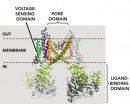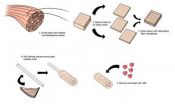Study shows early cognitive problems among those who eventually get Alzheimer's
2012-12-28
(Press-News.org) MANHASSET, NY -- People who study or treat Alzheimer's disease and its earliest clinical stage, mild cognitive impairment (MCI), have focused attention on the obvious short-term memory problems. But a new study suggests that people on the road to Alzheimer's may actually have problems early on in processing semantic or knowledge-based information, which could have much broader implications for how patients function in their lives.
Terry Goldberg, PhD, a professor of psychiatry and behavioral science at the Hofstra North Shore-LIJ School of Medicine and director of neurocognition at the Litwin Zucker Center for Research in Alzheimer's Disease and Memory Disorders at The Feinstein Institute for Medical Research in Manhasset, NY, said that clinicians have observed other types of cognitive problems in MCI patients but no one had ever studied it in a systematic way. Many experts had noted individuals who seemed perplexed by even the simplest task. In this latest study, published in this month's issue of the American Journal of Psychiatry, investigators used a clever series of tests to measure a person's ability to process semantic information.
Do people with MCI have trouble accessing different types of knowledge? Are there obvious semantic impairments that have not been picked up before? The answer was "yes."
In setting out to test the semantic processing system, Dr. Goldberg and his colleagues needed a task that did not involve a verbal response. That would only confuse things and make it harder to interpret the results. They decided to use size to test a person's ability to use semantic information to make judgments between two competing sets of facts. "If you ask someone what is bigger, a key or an ant, they would be slower in their response than if you asked them what is bigger, a key or a house," explained Dr. Goldberg. The greater the difference in size between two objects, the faster a person -- normal or otherwise -- can recognize the difference and react to the question.
Investigators brought in 25 patients with MCI, 27 patients with Alzheimer's and 70 cognitively fit people for testing. They found large differences between the healthy controls and the MCI and Alzheimer's patients. "This finding suggested that semantic processing was corrupted," said Dr. Goldberg. "MCI and AD (Alzheimer's disease) patients are really affected when they are asked to respond to a task with small size differences."
They then tweaked the task by showing pictures of a small ant and a big house or a big ant and a small house. This time, the MCI and AD patients did not have a problem with the first part of the test -- they were able to choose the house over the ant when asked what was bigger. But if the images were incongruent – the big ant seemed just as big as the small house – they were confused, they answered incorrectly or took longer to arrive at a response.
Patients with MCI were functioning somewhere between the healthy people and those with AD. "When the decision was harder, their reaction time was slower," he said.
Would this damaged semantic system have an effect on everyday functions? To answer this question, investigators turned to the UCSD Skills Performance Assessment scale, a tool that they have been using in MCI and AD patients that is generally used to identify functional deficits in patients with schizophrenia. The test taps a person's ability to write a complex check or organize a trip to the zoo on a cold day.
This is actually a good test to figure out whether someone has problems with semantic knowledge. Semantic processing has its seat in the left temporal lobe. "The semantic system is organized in networks that reflect different types of relatedness or association," the investigators wrote in their study. "Semantic items and knowledge have been acquired remotely, often over many repetitions, and do not reflect recent learning."
Dr. Goldberg said the finding is critically important because it may be possible to strengthen these semantic processing connections through training. "It tells us that something is slowing down the patient and it is not episodic memory but semantic memory," he said. They will continue to study these patients over time to see if these semantic problems get worse as the disease advances.
In an accompanying editorial, David P. Salmon, PhD, of the Department of Neurosciences at the University of California in San Diego, said that the "semantic memory deficit demonstrated by this study adds confidence to the growing perception that subtle decline in this cognitive domain occurs in patients with amnestic mild cognitive impairment. Because the task places minimal demands on the effortful retrieval process, overt word retrieval, or language production, it also suggests that this deficit reflects an early and gradual loss of integrity of semantic knowledge."
He added that a "second important aspect of this study is the demonstration that semantic memory decrements in patients with mild cognitive impairment may contribute to a decline in the ability to perform usual activities of daily living."
###
About The Feinstein Institute for Medical Research
Headquartered in Manhasset, NY, The Feinstein Institute for Medical Research is home to international scientific leaders in many areas including Parkinson's disease, Alzheimer's disease, psychiatric disorders, rheumatoid arthritis, lupus, sepsis, human genetics, pulmonary hypertension, leukemia, neuroimmunology, and medicinal chemistry. The Feinstein Institute, part of the North Shore-LIJ Health System, ranks in the top 5th percentile of all National Institutes of Health grants awarded to research centers. For more information visit www.FeinsteinInstitute.org.
ELSE PRESS RELEASES FROM THIS DATE:
Research by CU-Boulder physicists creates 'recipe book' for building new materials
2012-12-28
By showing that tiny particles injected into a liquid crystal medium adhere to existing mathematical theorems, physicists at the University of Colorado Boulder have opened the door for the creation of a host of new materials with properties that do not exist in nature.
The findings show that researchers can create a "recipe book" to build new materials of sorts using topology, a major mathematical field that describes the properties that do not change when an object is stretched, bent or otherwise "continuously deformed." Published online Dec. 23 in the journal Nature, ...
Study reports racial disparities in pediatric appendicitis treatment tied to hospital type
2012-12-28
CHICAGO (December 28, 2012): When researchers from UCLA Medical Center investigated the link between racial disparities and appendicitis outcomes in children, they found that the type of hospital in which black, Hispanic and other minority patients receive care—community, children's or county—affects their odds of developing a perforated appendix. The study published in the January issue of the Journal of the American College of Surgeons is a first-of-its-kind look at the role hospital type plays in race-based treatment variances among this patient subset.
Appendicitis—a ...
Disease burden links ecology to economic growth
2012-12-28
A new study, published December 27 in the open access journal PLOS Biology, finds that vector-borne and parasitic diseases have substantial effects on economic development across the globe, and are major drivers of differences in income between tropical and temperate countries. The burden of these diseases is, in turn, determined by underlying ecological factors: it is predicted to rise as biodiversity falls. This has significant implications for the economics of health care policy in developing countries, and advances our understanding of how ecological conditions can ...
The factor that could influence future breast cancer treatment
2012-12-28
Australian scientists have shown in the laboratory how a 'transcription factor' causes breast cancer cells to develop an aggressive subtype that lacks sensitivity to estrogen and does not respond to known anti-estrogen therapies. The research, which has significant implications for breast cancer treatment, is published December 27 in the open access journal PLOS Biology.
Transcription factors are molecules that switch genes on or off. In this case, the transcription factor known as 'ELF5' inhibits sensitivity to estrogen very early in the life of a breast cancer cell. ...
Statin drug shows promise for fighting malaria effects
2012-12-28
(SALT LAKE CITY–Researchers have discovered that adding lovastatin, a widely used cholesterol-lowering drug, to traditional antimalarial treatment decreases neuroinflammation and protects against cognitive impairment in a mouse model of cerebral malaria. Although there are differences between mouse models of cerebral malaria and human disease, these new findings indicate that statins are worthy of consideration in clinical trials of cerebral malaria, according to an article published in the Dec. 27 issue of PLOS Pathogens.
Malaria, a parasitic infection that is transmitted ...
Staphylococcus aureus: Why it just gets up your nose!
2012-12-28
A collaboration between researchers at the School of Biochemistry and Immunology and the Department of Microbiology at Trinity College Dublin has identified a mechanism by which the bacterium Staphylococcus aureus (S. aureus) colonizes our nasal passages. The study, published today in the Open Access journal PLOS Pathogens, shows for the first time that a protein located on the bacterial surface called clumping factor B (ClfB) has high affinity for the skin protein loricrin.
S. aureus is a major human pathogen, with the potential to cause severe invasive diseases. It ...
The first genome sequence of Chinese plum provides important resource for fruit improvement
2012-12-28
December 27, 2012, Shenzhen, China - A Chinese research team, led by Beijing Forestry University, BGI, Beijing Lin Fu Ke Yuan Flowers Co., Ltd, and other institutes, has completed the first genomic sequence of Prunus mume, known as mei. This work is extremely important for the deeper understanding of Rosaceae evolution and provides an invaluable resource for the improvement of fruit trees. The latest study was published online today in Nature Communication.
As one of the longest-lived flowering fruit trees, the P. mume was domesticated in China more than 3,000 years ago. ...
Students' online and offline social networks can predict course grades -- Ben-Gurion U. researchers
2012-12-28
BEER-SHEVA, Israel, December 27, 2012 -- Ben-Gurion University of the Negev's (BGU) Social Networks Security Research Group in its Department of Information Systems Engineering has developed a novel method to predict how well or badly a student will perform in an academic course.
The information can be used to determine which students need the most help, as well as which ones excel and might be guided to further study or careers in that subject area. The paper, "Predicting Student Exam Scores by Analyzing Social Network Data," was presented earlier this month at the Advanced ...
A model-free way to characterize polymodal ion channel gating
2012-12-28
Two studies in The Journal of General Physiology (JGP) help pave the way for a "shortcut" model-free approach to studying activation of "polymodal" ion channels—channels that open in response to multiple stimuli. Transmembrane ion channels respond to various physiological stimuli to regulate numerous cellular functions. Different classes of channels respond to different types of stimuli; some channels, for instance, respond to changes in membrane potential whereas others are activated by ligand binding. Polymodal channels integrate different cellular signals, enabling them ...
Slice, stack, and roll: A new way to build collagen scaffolds
2012-12-28
MEDFORD/SOMERVILLE, Mass. (December, 26 2012) – Tufts University School of Engineering researchers have developed a novel method for fabricating collagen structures that maintains the collagen's natural strength and fiber structure, making it useful for a number of biomedical applications.
Collagen, the most abundant protein in the body, is widely used to build scaffolds for tissue engineering because it is biocompatible and biodegradable. Collagen is, however, hard to work with in its natural form because it is largely insoluble in water, and common processing techniques ...

